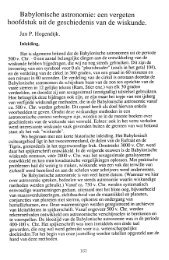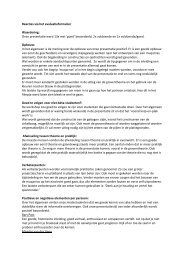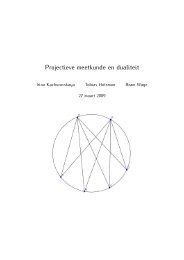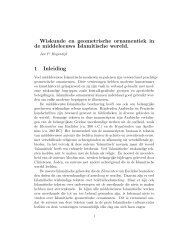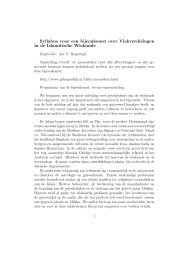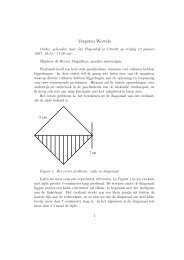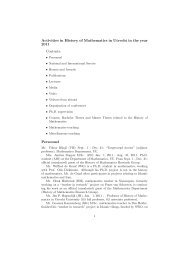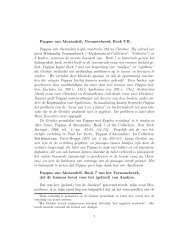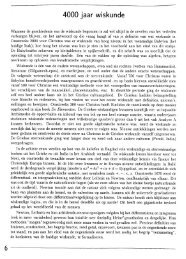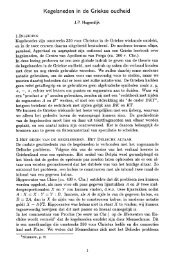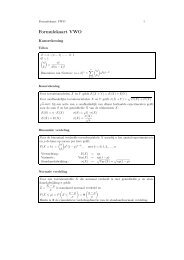Desargues' Brouillon Project and the Conics of ... - J.P. Hogendijk
Desargues' Brouillon Project and the Conics of ... - J.P. Hogendijk
Desargues' Brouillon Project and the Conics of ... - J.P. Hogendijk
Create successful ePaper yourself
Turn your PDF publications into a flip-book with our unique Google optimized e-Paper software.
20 Jan I! Hogrndijk<br />
(GD . GF) / (CD * CF) = AG/AC (3.1)<br />
<strong>and</strong> (GD. GF)/(CD. CF) = (GB. GH)/(CB. CH) . (3.2)<br />
He calls two pairs <strong>of</strong> points B, H; C, G mixed (meslez) if one point<br />
<strong>of</strong> each pair is between <strong>the</strong> two points <strong>of</strong> <strong>the</strong> o<strong>the</strong>r pair. He calls<br />
<strong>the</strong> two pairs unmixed (demeslez) if this is not <strong>the</strong> case, i.e. if no<br />
point <strong>of</strong> one pair lies between <strong>the</strong> points <strong>of</strong> <strong>the</strong> o<strong>the</strong>r pair, or if both<br />
points <strong>of</strong> one pair lie between <strong>the</strong> points <strong>of</strong> <strong>the</strong> o<strong>the</strong>r pair.<br />
He <strong>the</strong>n considers six points (more precisely: three pairs <strong>of</strong> points)<br />
B, H; C, G; D, F on a straight line. If <strong>the</strong>se six points satisfy (3.2)<br />
<strong>and</strong> are located in such a way that ei<strong>the</strong>r all pairs are mixed (Figure<br />
11, bottom) or all pairs are unmixed (Figure 11, top), <strong>the</strong>n Desargues<br />
says that <strong>the</strong>se six pointsform an involution. [T 110, FG 771<br />
Thus every three couples <strong>of</strong> points on a tree form an involution.<br />
Desargues also proves <strong>the</strong> converse: if six points B, H; C, G; D, F<br />
form an involution, <strong>the</strong>re is a point A such that A; B, H; C, G; D, F<br />
form a tree, <strong>and</strong> this stump A (<strong>and</strong> hence <strong>the</strong> tree) is uniquely<br />
determined.<br />
Four points in involution are defined as six points in involution <strong>of</strong><br />
which two pairs coincide, that is to say <strong>the</strong> case where C = G <strong>and</strong> D =<br />
F (Figure 11, middle). Because (HC.HG)/(BC. BG) = (HD.HF)/<br />
(BD . BF), we have HC2/BC2 = HD2/BD2, so that HC/BC = HD/<br />
BD, as above.<br />
Desargues also djscusses <strong>the</strong> point at infinity in connection with<br />
trees. In <strong>the</strong> tree <strong>of</strong> Figure 11, <strong>the</strong> stump A <strong>and</strong> <strong>the</strong> point at infinity<br />
are a pair <strong>of</strong> knots just like an ordinary pair B, H [T 11 5, FG 8 13.<br />
Although he does not explicitly say so, he clearly implies that <strong>the</strong><br />
point at infinity <strong>and</strong> five ordinary points can be six points in<br />
involution (compare [T 119-120, FG 84-85)). This means that if<br />
we write J for <strong>the</strong> point at infinity, <strong>the</strong> three pairs C, G; D, F <strong>and</strong><br />
A, J are six points in involution if (3.1) is satisfied <strong>and</strong> if A is between<br />
both pairs <strong>of</strong> points C, G <strong>and</strong> D, F or not between any <strong>of</strong> <strong>the</strong>se<br />
pairs. Note that (3.1) is a limiting case <strong>of</strong> (3.2) if B tends to A <strong>and</strong><br />
H to infinity.<br />
In modern projective geometry, an involution is a mapping 0 <strong>of</strong><br />
a straight line (including <strong>the</strong> point at infinity) onto itself which is a<br />
projectivity <strong>and</strong> its own inverse. Although <strong>the</strong> modern concept




